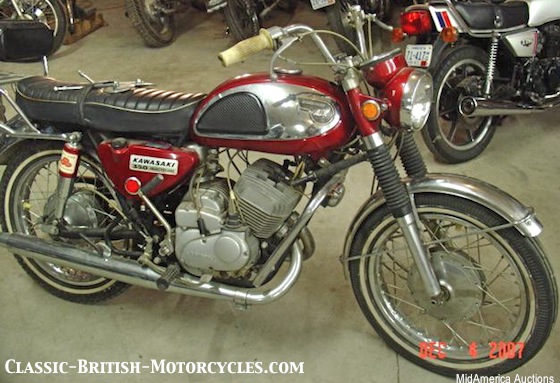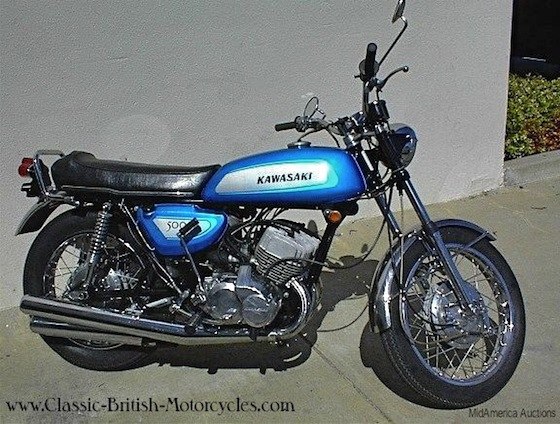KAWASAKI MOTORCYCLES – A BRIEF HISTORY
Kawasaki Heavy Industries got its start in 1878 building Western-style ships in Hyogo, Japan. By 1906 they had expanded into building locomotives & railroad cars. By World War II, Kawasaki Aircraft Co. was building planes for the Imperial Navy. After the war, this vast, diversified company continued to expand & consolidate. In 1950, Kawasaki opened its Steel Division & shortly after began producing scooters for the Japanese market. By 1954, they had graduated into small motorcycles, building them under license from Meguro Motorcycles of Japan. An odd assortment of Meguro designs were sold through the early 1960s. In 1963, Kawasaki Aircraft merged with Meguro Motorcycles, to form Kawasaki Motorcycles, but still making the same old Meguro designs. In an effort break into the 4-stroke heavyweight market, Kawasaki began producing the Meguro K1 as the Kawasaki W1, yet another ancient Meguro design, this one patterned after a BSA A7 OHV vertical twin.
KAWASAKI MOTORCYCLES – GETTING ROLLING
The bike was antiquated & obsolete from the start, BSA themselves having abandoned the design around the same time. And the Kawasaki W1 500cc vertical twin did about as well, as in…not very. While they continued to flirt with 4-stroke power, Kawasaki threw their substantial engineering might behind mass-market 2-stroke designs. The emphasis was put on performance at a low price, and it worked for Kawasaki. In the US market & elsewhere, their fortunes continually improved throughout the 1960s, as did their motorcycles. They got bigger, heavier, more powerful, faster, and flashier.

1968 Kawasaki 350 Avenger, a good example of the kind of “ugly duckling”-styling that the Japanese were peddling in those days.
KAWASAKI MOTORCYCLES – FINDING THEIR WAY
By the late 1960s, Kawasaki Motorcycles had proven that they could build high-quality, reliable motorcycles with good performance. They pushed the displacement envelope & worked on engine refinements that gave more power, better economy, longer engine life & better tractability. They settled on a Rotary Disk set up for induction. From the mid-60s on, all their 2-stroke singles & twins would use this highly effective system of timing the intake, similar to a cam & valves on a 4-stroke. A disk with a hose in one of it is attached to the end of the crank which spins the disk. The hole in the disk lines up with a hole in the crankcase at the precise optimum time. The carburetor feeds into the side cover of the engine on these designs. These hot little engines heled carve out a healthy chunk of the dirt bike boom that was taking place in the US at the time.

1970 Kawasaki G31 Centurion 100, one of Kawasaki’s early entrant in the Dirt Bike Wars of the early 70s.
KAWASAKI MOTORCYCLES – UGLY DUCKLINGS
While the engines were getting better & better, the styling left something to be desired. While Honda was beginning to adopt a more modern styling language, rewrit the book even, Kawasakis like Suzukis & Yamahas, somehow still looked oddly ‘Japanese’. Blocky bodywork, chrome sidepanels on tanks, square headlight housings, huge fenders, they just didn’t look cool. But help was on the way…and it was popping a wheelie!!

The 1970 Kawasaki H1 Mach 3 was a wicked machine in its day.
KAWASAKI MOTORCYCLES – TIME TO ROCK!
By the mid-1960s the US motorcycle market was heating up & they wanted red hot performance. Honda hit the market with a string of successively bigger & faster machines, from the 305 Super Hawk to the 450cc DOHC Black Bomber. Suzuki was quick to follow with its 2-stroke Titan 500cc twin. And rumors swirled that both the Brits (the Triumph Trident 750 triple) and Honda might be working on multi-cylinder 4-stroke ‘superbikes’. Kawasaki wanted to trump them all, at a time when their hottest bike was the 350cc Avenger 2-stroke twin. In 1967, Kawasaki embarked on their Plan N100 in secret, with the goal of producing an affordable 500cc motorcycle that would make 60 hp and run the quarter mile in under 13 seconds, both thought to be unattainable goals for a street bike in the late 60s.
KAWASAKI MOTORCYCLES – THE MACH 3 ARRIVES IN A CLOUD OF SMOKE
Released as a 1969 model, the result was a compact 499cc 3-cylinder air-cooled 2-stroke fed by three 26mm Mikuni carbs, and featuring a revolutionary new ignition system called Capacitor Discharge Ignition or CDI for short. It boosted the battery’s 12 volts all the way up to 25,000 volts. It had a power-to-weight ratio of only 6 pounds per horsepower, again unheard of in its day. These were just some of the ways Kawasaki found of eking out the kind of wicked performance that put the Mach 3, as Kawasaki called it’s 500 triple, in a performance class all of it’s own. Nothing else on the street could touch it…at least in a straight line. This thing was a drag bike, pure & simple, and could rip off quarter miles runs of 13-seconds or less. The story was quite different when the road got twisty. The handling was notoriously sloppy & even dangerous at high speeds. But despite its flaws, the Mach 3 was an enormous achievement & put the world on notice that Kawasaki had arrived, had ceased to be a follower, and was now an industry leader.



The Kawasaki Z1 was a 900cc 4-cylinder that once again put Kawasaki well ahead of its competition.
KAWASAKI MOTORCYCLES – THE MIGHTY Z1 HITS THE SCENE
While the 2-stroke triples (350, 500 & 750) were doing very well for Kawasaki, they saw the handwriting on the wall. The 2-stroke streetbike was going the way of the dodo bird & they needed a world-class 4-stroke heavyweight right away. In truth, Kawasaki had been working on it’s own SOHC (Single OverHead Cam) 4-cylinder engine, but when Honda beat it to the punch with their game-changing 750 Four in 1969, it was back to the drawing board. Everything in the original design was beefed up. The 750cc displacement was pushed up to 903cc and the SOHC was replaced with a DOHC set up. The result was a big, powerful, smooth machine that took everyone by surprise. How did Kawasaki do it? Up until now, they’d only had some fairly crude, but very fast, 2-strokes. They had quickly leapfrogged the competition right to the top of the heap, with 82 hp and a top speed of 130 mph, both figures unbeatable in 1972 when the big Kawi debuted as the Z1.
KAWASAKI MOTORCYCLES – ONWARD & UPWARD
Of course by 1972, the British motorcycle industry was in cardiac arrest. BSA, the once-might giant of industry, had just closed its doors. Norton was still showing signs of life, but could never reach the levels of production that the Japanese were cranking out at that time, and would produce their last Norton Commando in 1975. That left only Triumph still plugging along, but about to hit a brick wall with labor problems that would end up shutting the Meriden factory & seal Triumph’s fate. They limped along producing just a handful of Bonnevilles until they finally gave up in 1983. Kawasaki, on the other hand, much like the rest of the “Japanese Big 4” faired quite well, going from success to success. They expanded their dirt bike presence at the same time they built up their street cred with continually faster & more powerful 4-stroke machines, including the seminal Ninja series. Kawasaki abandoned 2-stroke engines within a few years, and invested wholeheartedly in 4-stroke technology.



